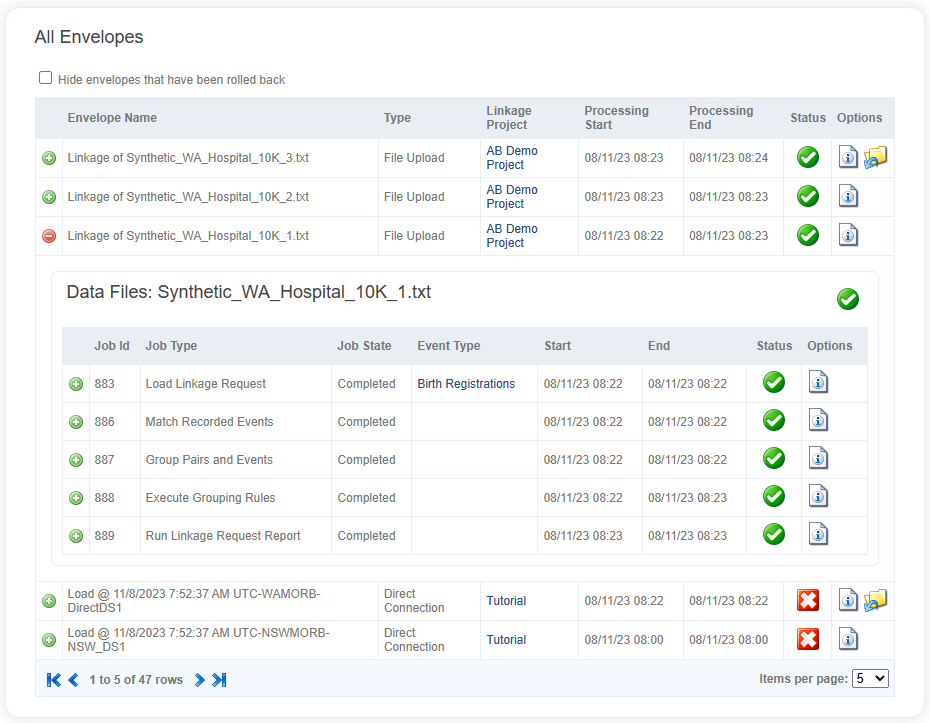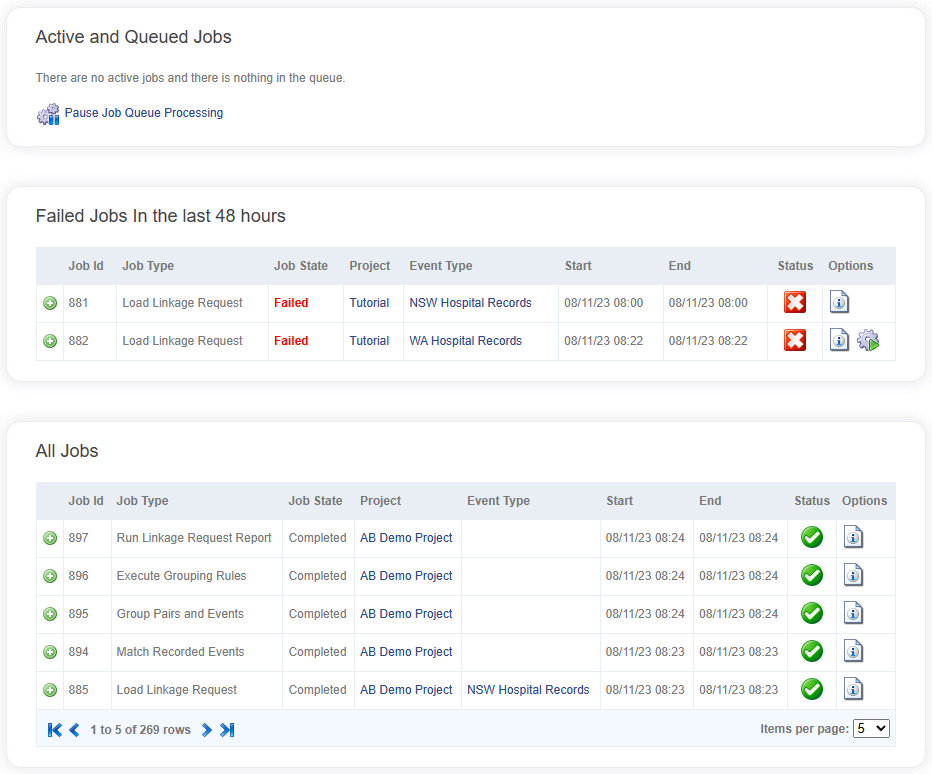Monitoring jobs and envelopes
All data processing by the system is run through the Job Queue. This includes all data loads, matching, grouping, reporting, extractions and rollbacks. Jobs are added to the queue and run sequentially in the background.
Jobs that are run specifically for an Envelope - whether created explicitly by uploading an Envelope file or implicitly through a single data file upload - are grouped and chained together. This ensures that the set of jobs required to process an envelope are all run together, and it also allows the user to group the jobs by envelope.
Click on the JOBS tab to view the jobs. There are two views available to you:
ALL ENVELOPES- the default view, this shows a list of all Envelopes, expandable to view the Jobs for eachALL JOBS- views a plain list of Jobs, ordered by processing start date
All envelopes
At the top of the page is a panel allowing you to upload Envelopes directly to the system. Details of this can be found in Loading in an Envelope.
The remainder of the page gives you a list of all Envelopes that have been loaded into the system, as well as a separate panel showing actively processing envelopes and recently errored envelopes.

Clicking on the green plus button in the first column of the Envelopes table will expand out to display a list of all the jobs that have run within the context of that Envelope. Each job can also be expanded to show some stats specific to that job.
The Status column shows icons that indicate the current status of the Envelope.
| Icon | Status |
|---|---|
| The Envelope completed processing successfully. | |
| The Envelope is actively processing data successfully. | |
| The Envelope completed processing with error. | |
| The Envelope is actively processing data but errors have occurred. | |
| The Envelope was found to be corrupt and cannot be used. | |
| The Envelope has been cancelled and will not continue processing. | |
| The Envelope has been rolled back by the user. |
The Options column will show clickable icons that are applicable to the Envelope.
| Icon | Action |
|---|---|
| Clicking this will display a popup showing all notifications that were raised during the processing of the Envelope. | |
| Allows you to completely roll back the changes to data as a result of this envelope. |
All jobs
This view displays a list of all Jobs that have been run by the system. This includes all jobs run for Envelopes as well as other system jobs that may not be associated with a single Envelope.

Similarly to Envelopes, clicking on the green plus button in the first column of the Jobs table will expand out to display any statistics for that job.
| Icon | Status |
|---|---|
| The Job completed processing successfully. | |
| The Job is actively running and no errors have occurred. | |
| The Job has failed due to an error or because it was cancelled. | |
| The Job is running but errors have occurred. |
The Options column will show clickable icons that are applicable to the Job.
| Icon | Action |
|---|---|
| Clicking this will display a popup showing all audit messages specific to the Job. | |
| Allows you to retry the Job if it failed unexpectedly. Jobs can be retried if they have failed and no other Jobs have been run against that same Linkage Project. |
Job queue processing
The job queue processing can be paused and resumed manually, if the user has the appropriate permissions. If the queue processing is active, a Pause Job Queue Processing link is provided in the Active and Queued Jobs panel at the top of the page. If it is currently paused, a Resume Job Queue processing link is provided. Pausing and resuming the queue will both present a confirmation dialog to the user.
Pausing the queue will not stop the currently running job (if any). It will simply prevent any more queued jobs from being started.
If there are one or more queued jobs in the queue, a Clear Job Queue link is provided. This will completely remove all queued jobs. Any running job will continue to proceed.
A system configuration setting, Worker.Jobs.PauseProcessingOnFailure, will, if set to True, automatically pause the job queue processing if any job fails. This is particularly useful if an error has ocurred due to unforseen infrastructure issues (e.g. database size limit reached), allowing you to correct the issue, retry the job and resume the job queue.